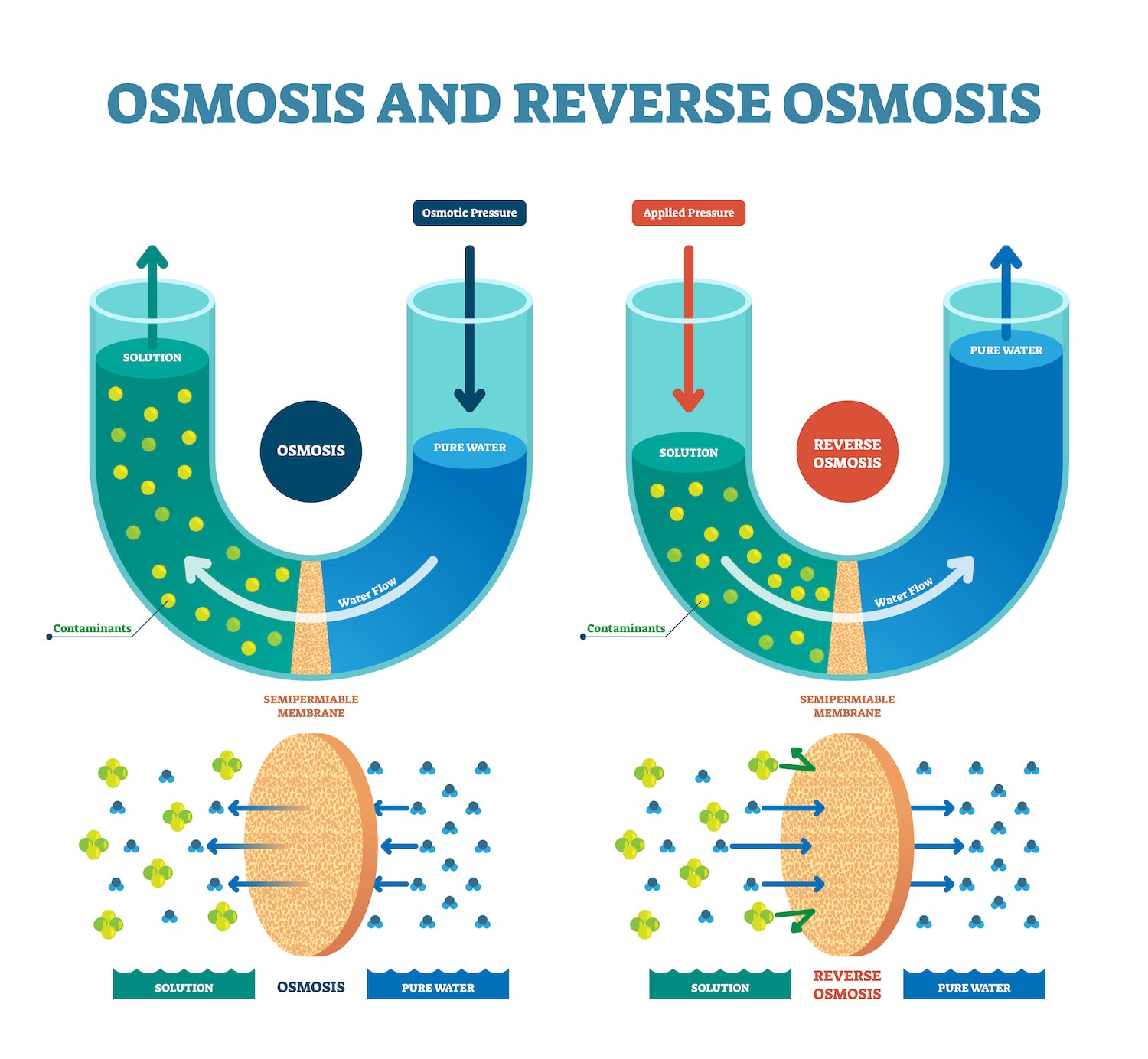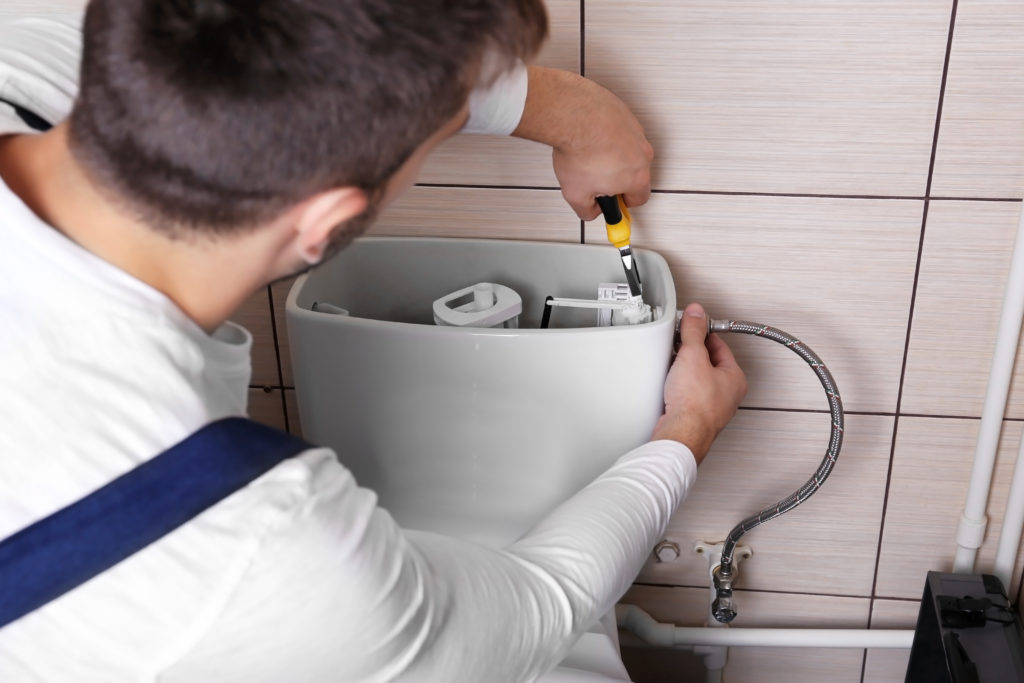You might think reverse osmosis is just some scientific process occurring within a lab bubbling beaker. But the reality is that reverse osmosis (RO) is also actually happening right within your home. Or, at least, it should be!
More and more people are choosing reverse osmosis filtered water for their homes. That’s because it can provide a swath of great benefits, such as:
- Cleaner drinking water
- Better tasting food
- Extra money savings
- Simple maintenance
- Healthier, more hydrated families
So how does reverse osmosis work? We’re here to cover every question you might have about reverse osmosis membranes and your own RO system.
What Is Reverse Osmosis? 🔄

Many American homes have an RO system these days. Still, most people have no clue how the reverse osmosis process actually operates or what their reverse osmosis system is, to begin with. But we’re here to change that.
In scientific terms, reverse osmosis is a process (or a reversal of a process) that happens within, well, pretty much everything. All cell-based organisms perform RO naturally, and your RO system simply harnesses the power of that natural process.
Wait, what?
To fully understand reverse osmosis, you’ll need a firm grasp on regular old osmosis first. During osmosis, a solution will pass through a semi-permeable membrane, flowing into a more concentrated solution to equalize the solutions on both sides. For example, when your fingers get all wrinkled after being underwater for too long.
So, although you might think there’s no reason to reverse an already equal solution, the name is a bit of a red-herring. Reverse osmosis actually allows a solution (or water) to pass through a membrane surface to become a less concentrated solution on the other side. In a reverse osmosis system, water passes through the membrane with help from external pressure, while larger molecules and contaminants are blocked from the concentrate flow.
This is how you wind up with a fully filtered solvent or, simply, pure water.
How Do Household Reverse Osmosis Systems Work?
Reverse osmosis systems use “osmotic pressure” or your household water pressure to push water through several filters, including that semipermeable membrane we talked about.
The high-pressure pumps move smaller water molecules to another, lower-pressure vessel while larger contaminants are rejected, leaving behind high-quality water for your family to consume. However, your reverse osmosis system will block all large molecules, meaning it removes beneficial minerals sometimes.
These are the four steps that typically take place within most RO systems found in residential households:
- Pre-filtration process – a high-pressure pump sends feed water through a system of initial sediment and carbon filtration membranes. This is where early issues like dust, rust, and unpleasant tasting sediments are removed.
- Reverse osmosis – feed water passes through the reverse osmosis membrane with help from high water pressure, reducing around 95% of contaminants at this point.
- Specialty filtration – some RO systems come equipped with additional filtration technology to ensure you receive truly fresh water every time.
- Drainage and storage tank – After reverse osmosis and filtration take place, the clean water is stored in your RO system’s storage tank until you’re ready to use it. When you turn on the top, the water will run through one final filter to ensure you get crisp, clean, good-tasting water no matter what.
You can install a whole house reverse osmosis system that supplies your drink water as well as shower, toilet, and other plumbing system water, or simply opt for the more popular, singular under-sink option, which is incredibly easy to set up and maintain.
Do I Need a Reverse Osmosis Membrane Installed?
That’s completely up to you, but we believe RO systems are a great investment for residential homes. They act as an excellent sediment filter, removing sodium, arsenic, and other harmful contaminants while working more efficiently than other water systems. (And they’re much easier to maintain and replace, we might add.)
Average RO System Installation Cost 💰
- Whole house: $12,000-$18,000
- Under-sink RO system: ~$1,000 on average (can be higher or lower)
Depending on the type of RO system you settle on, the installation cost can vary, so talk with your local plumber to determine what reverse osmosis unit best suits your needs.
Benefits of a Reverse Osmosis System ✅
As we mentioned above, RO membranes come with many great benefits. Examples of why you might install a reverse osmosis filtration system include:
Reverse Osmosis Water Is Safer to Drink 🚱
Installing a reverse osmosis system can result in cleaner household drinking water. That’s because the RO membrane participates in a water purification process that removes certain toxins and raises water quality. RO membranes can filter out contaminants like:
- Sodium
- Copper
- Chloride
- Rhodium
- Lead
- Arsenic
- Sulfate
- Nitrate
Removing these contaminants can be a crucial asset for anyone struggling with gut health issues. With an RO system, you get fresh water that’s safe to drink and doesn’t upset your stomach like other drinking water from a regular tap.
RO Systems Improve Water’s Taste, Odor & Appearance 👃
No more chlorine tastes in the city water you want to drink from your sink tap or those weird, way-too-powerful smells coming from your townhouse kitchen drains. Installing an RO system can help improve the overall taste, odor, and appearance of household water, as well as the taste or flavor of your food. That’s because RO water is contaminant-free and virtually flavorless.
These Systems Are Simple to Maintain 🔧
Like your everyday filtration system, RO systems need a tiny bit of maintenance to stay in tip-top shape. But it’s super simple: swapping out the filters regularly is all you need to do to keep your RO unit working its best.
Clean Water Supply Encourages Families to Consume More Drinking Water 💧
You might not have even thought about it, but a cool RO system can make it fun to drink water! Families can work together with children to manage the filters and ensure they’re changed when necessary. Plus, the pure water will seem much more tasty and enticing to impressionable young kids. It’s a great way to get everyone to stay adequately hydrated.
You’ll Save Money on Bottled Water Products 🤑
The way your RO system design works is to hold onto clean reverse osmosis water until you’re ready to use it. However, your tank can only hold so much. In order to minimize waste and take full advantage of the benefits reverse osmosis water has to offer, purchasing glass bottles to capture and store the RO filtered water is a good idea. Now, you can say goodbye to buying unnecessary bottled water products as well.
Potential Drawbacks of Reverse Osmosis Process ❌
As we mentioned, reverse osmosis removes minerals and contaminants that can be harmful to your gut health. However, an RO membrane will take out ALL molecules and contaminants in your water, meaning you might not get some of the stuff the EPA says is good for us, such as:
- Calcium
- Magnesium
- Potassium
- Fluoride
So, search for a filter that adds back these minerals to get the key nutrients and familiar flavoring your body needs for the best results.
Get the Best Reverse Osmosis Systems 👍
At AJ Alberts, our seasoned plumbers are here to help when you’re considering a reverse osmosis system for your home. We have plenty of recommendations to make when it comes to Novo reverse osmosis systems. In particular, the Aqua Flo Platinum QCRO and QCUF systems, both of which can be tailored perfectly to your home water supply needs.
Want to learn more about these fantastic reverse osmosis system options? Get in touch with our accomplished team today.








